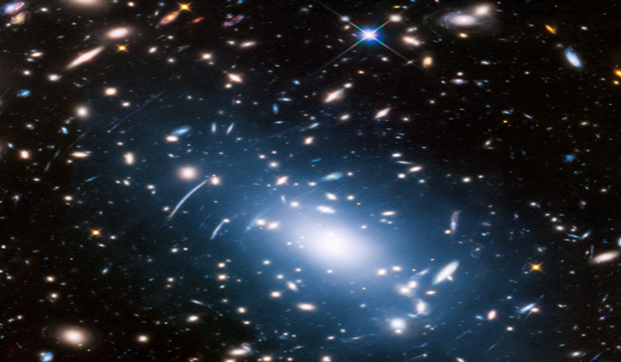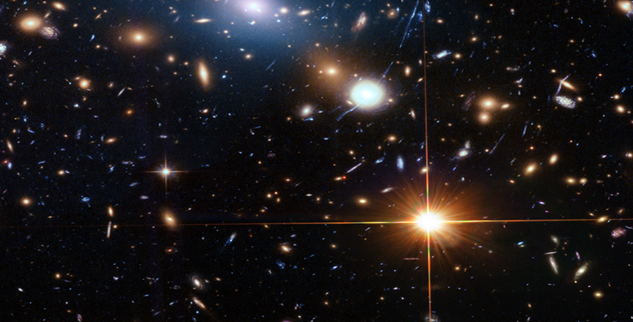by Rida Fatima

(Fig 1: The Abell S1063 cluster contains a vast number of galaxies, and Hubble’s exceptional sensitivity and resolution have been able to catch an intracluster light, a gentle blue haze. The stars that are responsible for this glow have been expelled from their galaxy. These stars are no longer members of a galaxy and now lead solitary lives, aligning themselves with the gravitational pull of the larger cluster. Intracluster light has been discovered to be a good predictor of the distribution of dark matter in the cluster because of its association with a map of mass distribution in the cluster’s general gravitational field. Credits: NASA and M. Montes.)
The dark matter has enigmatic nature, the unobservable substance which forms most of the cosmos, may be revealed by a fresh study of Hubble photographs of galaxies. It is proved by the astronomers that the diffuse glow that exists between the galaxies in a cluster, also known as intracluster light, can help to trace the path of dark matter, and also help to illuminate the distribution pattern more precisely as compared to the current methods which observe and understand the study through X-ray light. Using Hubble’s earlier images of six giant galaxy clusters from the Frontier Fields mission, they were able to accomplish this. Intergalactic interactions that upend their structures result in intracluster light, which is produced as individual stars are liberated from the gravitational grip of their parent galaxy and realigned with the gravity map of the entire cluster. Additionally, the great majority of dark matter is found here. Where galaxies are colliding is visible in X-ray light, but the cluster’s underlying structure is not revealed. As a result, it is not very authentic and precise to trace the paths of dark matter.
“As the intracluster light is relatively free-floating on the gravity of the cluster itself, which leads it to follow the same gravity, this particular reason makes intracluster light the best way to trace the dark matter in the solar system,” says co-author Mireia Montes. Additionally, we have discovered this precise method to predict the location of the dark matter because we have found a new method to determine the placement of the dark matter as you are monitoring the identical gravitational potential. Our ability to locate dark matter is made possible by a very faint light. (NASA, 2018).
Intracluster Light In The Detection Of Dark Matter
Montes also emphasises that the technique is not only more accurate but also more effective because it just uses deep imaging as opposed to the more involved, time-consuming spectroscopy techniques. As a result, more clusters and objects in space may be researched in less time, providing more possible information about the composition and behaviour of dark matter. The final nature of dark matter may now be statistically characterised thanks to this technology, Montes stated.
The Canary Islands Institute of Astronomy’s Ignacio Trujillo, who co-authored the report and has worked with Montes on intracluster light studies for many years, stated, “The concept for the research was prompted by examining the pristine Hubble Frontier Field photos. Intracluster light was displayed with unparalleled clarity in the Hubble Frontier Fields.” The pictures were motivating, according to Trujillo. “However, I did not anticipate the results to be so accurate. Exciting possibilities exist for the research opportunities in future for space related projects.
A shape matching metric called Modified Hausdorff Distance is used by the astronomer, which helps with the comparison of the contours of the intracluster light. It also compares the different mass maps of the clusters, which are used as a significant part of the data from the Hubble Frontier Fields project, and is placed in the Mikulski Archive for Space Telescopes (MAST). The MHD is a metric for the distance between two groups. The two-point sets become more equivalent when MHD’s value decreases. Based on archived observations from the Advanced CCD Imaging Spectrometer of the Chandra X-ray Observatory, the analysis’s findings showed that the intracluster light distribution visible in the Hubble Frontier Fields images more closely matched the mass distribution of the six galaxy clusters than did X-ray emission. (NASA, 2018).

(Fig 2: The galaxy cluster MACS J0416.1-2403 also produces a gentle glow of intracluster light, formed by stars that are not a part of any particular galaxy, amidst the intense light of its component galaxies. Long ago, when the gravitational pull of the cluster tore apart their home galaxies, these stars were dispersed throughout the cluster. Eventually, the wandering stars aligned with the cluster’s general gravitational pull. The feeble light is captured by Hubble’s superior sensitivity and resolution, which is then used to pinpoint the location of unseen dark matter, which dominates the cluster’s gravitational field. Credits: NASA and M. Montes.)
Montes and Trujillo see numerous potentials to broaden their research beyond this initial investigation. They first want to see how well the tracing accuracy holds true before expanding the observing area in the initial six clusters. To expand the data set and validate their results, more research teams’ observation and analysis of galaxy clusters will be a crucial test of their methodology. The WFIRST and the James Webb Space Telescope, which will include far more sensitive instruments for detecting weak intracluster light in the farthest regions of the galaxy, are two strong future space-based telescopes that the astronomers anticipate utilizing the same techniques with.
Conclusion
Trujillo wants to test reducing the method’s scalability from enormous galaxy clusters to solitary galaxies. Exploring the star corona, for example, at galactic sizes would be great. The same concept should, in theory, be true; the celestial bodies that have surrounded the star system as consequences of its blending activity should likewise be tracking its gravity and revealing its dark matter distribution (Kimdeyir, 2018). In order to see the incredibly far-off galaxies beyond them and to understand more about how galaxies have evolved since the early (remote) universe, the Hubble Frontier Fields programme was developed. It was a deep imaging project. In that research, the diffuse intracluster light was a problem since it partially hid the far-off galaxies beyond (Kimdeyir, 2018).
References
- Faint glow within galaxy clusters illuminates dark matter. (2018, December). Kimdeyir. Retrieved December 2022, from https://kimdeyir.com/faint-glow-within-galaxy-clusters-illuminates-dark-matter/
- Faint Glow Within Galaxy Clusters Illuminates Dark Matter. (2018, December). NASA. Retrieved December 2022, from http://www.nasa.gov/image-feature/goddard/2018/faint-glow-within-galaxy-clusters-illuminates-dark-matter
